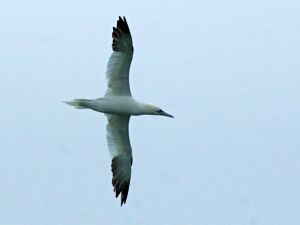
13 September 2008
I see my favorite sea bird twice a year because I migrate to the same places he does: Maine in September and Florida in February.
Northern gannets (Sula bassana) are huge birds with a 6.5 foot wing span and pointy wings, bill and tail. Related to boobies, gannets eat fish and squid along the continental shelf on both sides of the North Atlantic. Not only do they nest communally, but they hunt in large flocks when they discover that predators have forced their prey to the surface.
My favorite feature of northern gannets is their hunting technique.
Gannets fly into the wind looking down for prey. Because of their long pointed bill, their bodies look like upside down checkmarks from a distance. Thirty to 130 feet above the ocean, the gannet spies a fish and begins his head-first dive making his body and wings into the shape of a W. Just before he hits the water he straightens his wings tight against his body and enters the water like an arrow. Gannets dive at speeds exceeding sixty miles per hour so they have air sacs in their faces and chest which cushion the impact like bubble wrap.
Northern gannets nest colonially on island cliffs, principally in Scotland, Ireland, Norway and Canada. They lay one egg per year and incubate it by covering it with their webbed feet. They feed the nestlings by regurgitation, flying up to 300 miles in search of food.
When young gannets leave the nest they weigh 50% more than their parents and have fat reserves that last one to two weeks. That’s because they are completely on their own and too heavy to fly up out of the water in their first few days after fledging. Instead they immediately begin migration by swimming southward, learning to hunt and fly as they go.
They’re on their way from Canada now. I’ll see them in Florida in five months.
(photo by Chuck Tague)